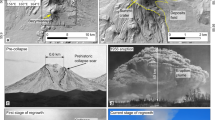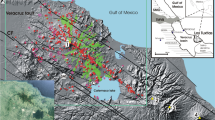Abstract
Air photographs taken in 1946, 1960, and 1982, together with SPOT HVR-1 images obtained in April and October of 1988, are used to characterize recent activity in and around the caldera of Fernandina Volcano, West Galapagos Islands. The eruptive and collapse events during this time span appear to be distributed in a NW-SE band across the summit and caldera. On the flanks of the volcano, subtle topographic ridges indicate that this is a long-term preferred orientation of extra-caldera activity as well (although radial and arcuate fissures are found on all sectors). The caldera is formed from the coalescence of multiple collapse features that are also distributed along a NW-SE direction, and these give the caldera its elongate and scalloped outline. The NW and SE benches consist of lavas that ponded in once-separated depressions that have been incorporated into the caldera by more recent collapse. The volume of individual eruptions within the caldera over the observed 42 years appears to be small (∼4x106 m3) in comparison to the volumes of individual flows exposed in the caldera walls (∼120–150x106 m3). Field observations (in 1989) of lavas exposed in the caldera walls and their cross-cutting relationships show that there have been at least three generations of calderas, and that at times each was completely filled. An interplay between a varying supply rate to the volcano and a regional stress regime is suggested to be the cause of long-term spatial and volumetric variations in activity. When supply is high, the caldera is filled in relative to collapse and dikes tend to propagate in all directions through the edifice. At other times (such as the present) supply is relatively low; eruptions are small, the caldera is far from being filled in, and dike propagation is influenced by an extra-volcano stress regime.
Similar content being viewed by others
References
Chadwick WW, Howard KA (1991) The pattern of circumferential and radial eruptive fissures on the volcanoes of Fernandina and Isabela islands, Galapagos. Bull Volcanol 53:257–275
Chadwick WW, De Roy T, Carrasco A (1991) The September 1988 intracaldera avalanche and eruption at Fernandina volcano, Galapagos Islands. Bull Volcanol 53:276–286
Chevrel M, Courtois M, Weill G (1981) The SPOT satellite remote sensing mission. Photogram Engineer Rem Sens 47:1163–1171
Dieterich JH (1988) Growth and persistence of Hawaiian rift zones. J Geophys Res 93:4258–4270
Duffield WA, Stieltjes L, Varet J (1982) Huge landslide blocks in the growth of Piton De La Fournaise, La Reunion, and Kilauea volcano, Hawaii. J Volcanol Geotherm Res 12:147–160
Filson J, Simkin T, Leu LK (1973) Seismicity of a caldera collapse: Galapagos Islands 1968. J Geophys Res 78:8591–8622
Fiske RS, Jackson ED (1972) Orientation and growth of Hawaiian volcanic rifts: the effect of regional structure and gravitational stresses. Proc R Soc London A-329:299–326
Hey RN, Deffeyes KS, Johnson GL, Lowrie A (1972) The Galapagos triple junction. Nature 237 p 20
Holcomb RT (1987) Eruptive history and long term behaviour of Kilauea volcano. US Geol Surv Prof Pap 1350:261–350
Lockwood JP, Lipman PW (1987) Holocene eruptive history of Mauna Loa volcano. US Geol Surv Prof Pap 1350:509–535
Macdonald GA (1965) Hawaiian calderas. Pacific Science 19:pp 320–334
Macdonald GA (1972) Volcanoes. Prentice-Hall, Inc, Englewood Cliffs, 510 pp
Macdonald GA, Abbot AT, Peterson FL (1983) Volcanoes in the sea the geology of Hawaii. University of Hawaii Press, Honolulu, 517 p
McBirney AR, Williams H (1969) Geology and petrology of the Galapagos Islands. Geol Soc Am Mem 118:197 pp
McClelland L, Simkin T, Summers M, Nielson E, Stein TC (1989) Global volcanism 1975–1985. Prentice Hall, Englewood Cliffs, 655 pp
McGuire WJ, Pullen AD (1989) Location and orientation of eruptive fissures and feeder-dykes at Mount Etna: influence of gravitational and regional tectonic stress regimes. J Volcanol Geotherm Res 38:325–344
Mouginis-Mark PJ, Pieri DC, Francis PW, Wilson L, Self S, Rose WI, Wood CA (1989) Remote sensing of volcanoes and volcanic terrains. EOS 52:1567–1575
Mouginis-Mark P, Rowland S, Francis P, Friedman T, Garbeil H, Gradie J, Self S, Wilson L, Crisp J, Glaze L, Jones K, Kahle A, Pieri D, Zebker H, Krueger A, Walter L, Wood C, Rose W, Adams J, Wolff R (1991) Analysis of active volcanoes from the Earth Observing System. Remote Sens Environ 36:1–12
Munro DC (1992) Applications of remotely-sensed data to studies of volcanism in the Galapagos Islands. PhD Dissertation, University of Hawaii
Munro DC, Mouginis-Mark PJ (1990) Eruptive patterns and structure of Isla Fernandina, Galapagos islands from SPOT-1 HRV and large format camera images. Int J Remote Sensing 11:1501–1509
Munro DC, Rowland SK, Mouginis-Mark PJ, Wilson L, Perez-Oviedo VH (1991) An investigation of the distribution of eruptive products on the shield volcanoes of the western Galapagos Islands using remotely sensed data. Proc 8th Them Conf Geol Rem Sens 1161–1174
Nakamura K (1982) Why do long rift zones develop better in Hawaiian volcanoes — a possible role of thick oceanic sediments. Bull Volcanol Soc Japan 25:255–267
Nordlie BE (1973) Morphology and structure of the western Galapagos volcanoes and a model for their origin. Geol Soc Am Bull 84:2931–2956
Perez-Oviedo VH (1991) Teledeteccion de la erupcion del 19 de Abril de 1991 in la Isla Fernandina. Informe interno, CLIRSEN
Richards AF (1962) Archipelago de Colon, Isla San Felix and Islas Juan Fernandez. In: Catalog of active volcanoes of the world 14. IAVCEI, Rome 50 pp
Richter DH, Eaton JP, Murata KJ, Ault WU, Krivoy HL (1970) Chronological narrative of the 1959–1960 eruption of Kilauea Volcano, Hawaii. US Geol Surv Prof Pap 537-E:73 pp
Rowland SK, Walker GPL (1990) Pahoehoe and a'a in Hawaii: volumetric flow rate controls the lava structure. Bull Volcanol 52:615–628
Simkin T (1972) Origin of some flat-topped volcanoes and guyots. Geol Soc Am Mem 132:183–193
Simkin T (1984) Geology of Galapagos Islands, in Galapagos key environments. Pergamon Press, Oxford:15–41
Simkin T, Howard KA (1970) Caldera collapse in the Galapagos Islands. Science 169:429–437
Simkin T, Fiske RS (1986) Volcano growth dominated by circumferential feeding systems: a morphogenetic comparison of Galapagos volcanoes with young volcanic seamounts. IAVCEI, New Zealand (not in abstract volume)
Simkin T, Siebert L, McClelland L, Bridge D, Newhall C, Latter JH (1981) Volcanoes of the world. Hutchinson Ross, Stroudsburg, 232 pp
Stearns HT (1946) Geology of the Hawaiian islands. Hawaii Div Hydrography Bull 8:106 pp
Walker GPL (1987) The dike complex of Koolau volcano. Oahu: internal structure of a Hawaiian rift zone. US Geol Surv Prof Pap 1350:961–996
Walker GPL (1988) Three Hawaiian calderas: an origin through loading by shallow intrusions? J Geophys Res 93:14773–14784
Walker GPL (1991) Structure and origin by injection of lava under surface crust, of tumuli, ‘lava rises’, ‘lava-rise pits’, and ‘lava-inflation clefts’ in Hawaii. Bull Volcanol 53:546–558
Williams H, McBirney AR (1979) Volcanology, Freeman, Cooper & Co, San Francisco, 397 pp
Author information
Authors and Affiliations
Rights and permissions
About this article
Cite this article
Rowland, S.K., Munro, D.C. The caldera of Volcan Fernandina: a remote sensing study of its structure and recent activity. Bull Volcanol 55, 97–109 (1992). https://doi.org/10.1007/BF00301123
Received:
Accepted:
Issue Date:
DOI: https://doi.org/10.1007/BF00301123




